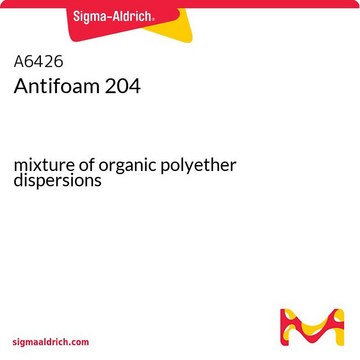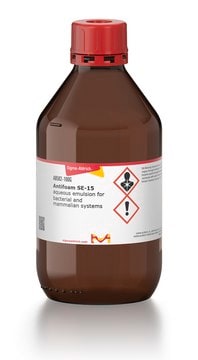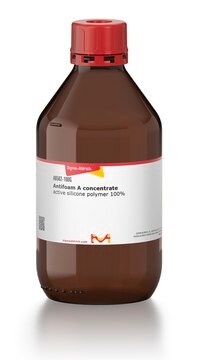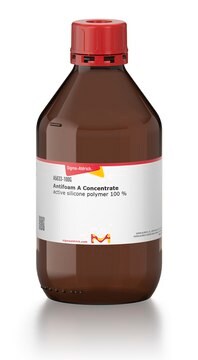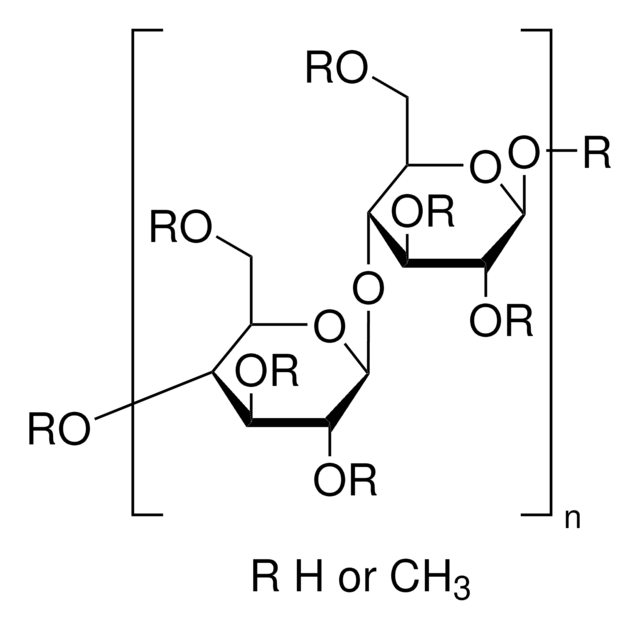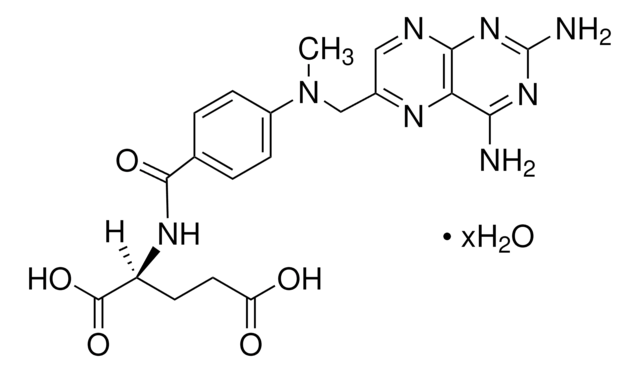A8011
Antifoam C Emulsion
aqueous-silicone emulsion
Synonym(s):
Antifoaming Agent Emulsion
Sign Into View Organizational & Contract Pricing
All Photos(1)
About This Item
UNSPSC Code:
12161900
NACRES:
NA.25
Recommended Products
biological source
synthetic
Quality Level
form
emulsion
contains
emulsifier
technique(s)
cell culture | hybridoma: suitable
microbiological culture: suitable
mp
0 °C (32 °F)
Related Categories
General description
Antifoam C emulsion is an aqueous emulsion containing 30% active silicone. This silicone-based antifoam emulsion consists of non-ionic emulsifiers different from those in antifoam emulsions B and Y-30. Antifoam C emulsion can be prediluted with 3-10 parts of cool water to aid in dispersion. Prediluted suspensions should be used immediately. Antifoam C emulsion is typically effective at 1-10 ppm. The flow properties of antifoam C emulsion are such that it can be pumped on an as-needed basis to a fermenter system with sufficient agitation to disperse the antifoam. Antifoam C emulsion can be used to regulate headspace foaming in mammalian cell culture bioreactors up to 30 ppm concentration.
Application
Antifoam C emulsion has been used:
- as a supplement in RO-H2O and a chemically defined culture medium to determine volumetric mass transfer coefficient (kLa) of mammalian cell culture
- as a component of feed medium,
- as a steam-sterilized antifoaming agent in a biocontroller for pH-stat fed-batch cultivations
- as a supplement in fed batch medium to mimic the typical large-scale cultivation conditions
Features and Benefits
- Minimizes compatibility issues with biological systems
- Highly effective defoamer at low concentrations
- Highly effective and versatile silicone defoamer
Other Notes
A 30% aqueous emulsion of polydimethylsiloxane concentrate.
For additional information on our range of Biochemicals, please complete this form.
signalword
Warning
hcodes
Hazard Classifications
Eye Irrit. 2 - STOT SE 3
target_organs
Respiratory system
Storage Class
10 - Combustible liquids
wgk_germany
WGK 3
flash_point_f
Not applicable
flash_point_c
Not applicable
ppe
Eyeshields, Gloves, type ABEK (EN14387) respirator filter
Choose from one of the most recent versions:
Already Own This Product?
Find documentation for the products that you have recently purchased in the Document Library.
Customers Also Viewed
Bernhard Sissolak et al.
Biotechnology journal, 14(7), e1800714-e1800714 (2019-04-16)
Frequently measured mammalian cell culture process indicators include viability and total cell concentration (TCC). Cell lysis, an additional important process characteristic that substantially contributes to the overall product purity profiles, is often not addressed in detail. In the present study
Gang Fu et al.
Biotechnology and applied biochemistry, 67(5), 812-818 (2019-10-08)
d-Psicose 3-epimerase is an enzyme that catalyzes the synthesis of d-psicose from d-fructose. We cloned the d-psicose 3-epimerase from Ruminococcus sp. (RDPE) and expressed it in Bacillus subtilis A311. By a two-step pH regulation of segmented fermentation, we significantly improved
Characterizing the Effects of Antifoam C Emulsion on Oxygen Mass Transfer within the BIOne Drilled-Hole Sparger and Microsparger Single-Use Bioreactor Systems
McAndrew J and Kauffman G
American Pharmacy null
Mervyn W O Liew et al.
Journal of biotechnology, 150(2), 224-231 (2010-08-28)
This study demonstrates the feasibility of large-scale production of murine polyomavirus VP1 protein in recombinant Escherichia coli as pentamers which are able to subsequently self-assemble in vitro into virus-like particles (VLPs). High-cell-density pH-stat fed-batch cultivation was employed to produce glutathione-S-transferase
Bernhard Sissolak et al.
Journal of industrial microbiology & biotechnology, 46(8), 1167-1178 (2019-06-09)
Recombinant monoclonal antibodies are predominantly produced in mammalian cell culture bioprocesses. Post-translational modifications affect the micro-heterogeneity of the product and thereby influence important quality attributes, such as stability, solubility, pharmacodynamics and pharmacokinetics. The analysis of the surface charge distribution of
Our team of scientists has experience in all areas of research including Life Science, Material Science, Chemical Synthesis, Chromatography, Analytical and many others.
Contact Technical Service